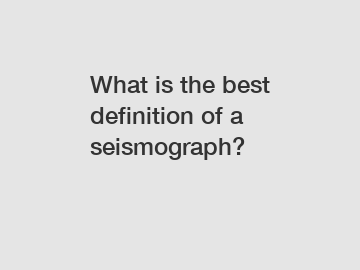What is the best definition of a seismograph?
When it comes to understanding earthquakes and monitoring seismic activity, a seismograph plays a crucial role. But what exactly is a seismograph, and how does it work? Let's dive into it.
What is a Seismograph?
A seismograph is a device used to measure and record the vibrations of the Earth caused by seismic waves, such as those generated by earthquakes, volcanic eruptions, or even explosions. It consists of a seismometer, which is a sensor that detects ground motion, and a recording device that records the data collected by the seismometer.

How Does a Seismograph Work?
1. Seismometer: The seismometer is equipped with a mass suspended on a spring. When the ground shakes, the mass remains stationary due to inertia, while the casing of the seismometer moves along with the ground motion. This relative motion between the mass and the casing is what is measured by the seismometer.
2. Recording Device: The data collected by the seismometer is recorded on paper or digitally by the recording device. The resulting seismogram, a record of ground motion over time, can provide valuable information about the strength, duration, and direction of seismic waves.
3. Interpretation: Seismologists analyze seismograms to determine the location, depth, and magnitude of earthquakes, as well as the propagation of seismic waves through the Earth's interior. This information is crucial for understanding earthquake hazards and mitigating their impact on society.
Why are Seismographs Important?
Seismographs are essential tools for monitoring and studying earthquakes, as well as for early warning systems that can alert people to impending seismic events. By detecting and recording ground motion, seismographs help scientists better understand the behavior of earthquakes and improve our ability to predict and prepare for them.
In addition to earthquake monitoring, seismographs are also used in scientific research, engineering projects, and even in detecting nuclear explosions. Their versatility and accuracy make them indispensable in various fields of study and practical applications.
Contact Us for Seismograph Suppliers.
If you are looking for high-quality seismographs for your research or monitoring needs, contact us today. We work with reliable suppliers who offer a wide range of seismograph models to suit your specific requirements. Whether you need a portable seismograph for fieldwork or a sophisticated system for a monitoring station, we can help you find the right equipment.
Don't hesitate to reach out to us for more information about seismographs, including pricing, technical specifications, and ordering details. Our team is here to assist you in selecting the best seismograph for your project and ensuring that you have the tools you need to conduct your work effectively.
In conclusion, a seismograph is a vital instrument for studying earthquakes and monitoring seismic activity. Its ability to detect and record ground motion provides valuable data for seismologists, engineers, and researchers, helping us better understand and prepare for earthquakes. If you are in need of a seismograph, contact us to connect with reliable suppliers who can meet your equipment needs.
Are you interested in learning more about Seismic Survey Equipment, Passive Source Seismic Surveys, Short-Period Seismic Nodes? Contact us today to secure an expert consultation!

Comments
0